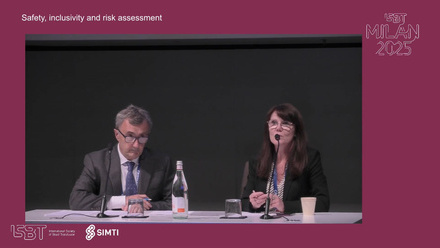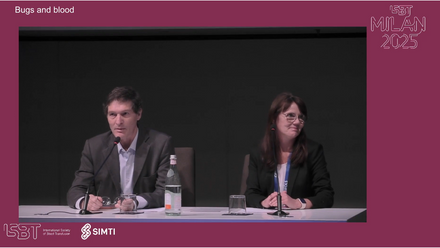The Epidemiology goes viral session included the following presentations:
1. Laura Tonnetti: The Impact of Babesia Testing on Transfusion-transmitted Babesiosis
2. Wen-Jie Liu: Ten-year experience of mini-pool nucleic acid testing in blood donors in Taiwan
3. Brian Custer: Prevalence, Incidence, and Residual Risk of HIV, HBV, and HCV in the US Blood Supply 2015 – 2021, on Behalf of the US TTIMS Program
4. Eduard Grebe: HIV incidence in US first-time blood donors during 12-month and 3-month MSM deferral policy periods on behalf of the US TTIMS Program
5. Daniel Candotti: Ten years insight into HBV molecular epidemiology in infected blood donors in Dalian, Northeast China
MODERATORS: Dudi Levi, Dorte Holm
After the presentation, there was a questions and answers session, which is also included in the recording.
Abstract
The impact of babesia testing on transfusion-transmitted babesiosis
L Tonnetti1
1American Red Cross, Rockville, United States
Background: The intraerythrocytic parasite Babesia microti, endemic in the north-eastern and mid-western United States, has been considered the leading cause of transfusion-transmitted infection in the US for decades.
Aims: Provide an update on the impact of babesia testing on transfusion-transmitted babesiosis (TTB).
Methods: American Red Cross (ARC) implemented babesia blood donation screening in May 2020 in 14 states on the East Coast (Northern and Mid-Atlantic), plus Washington DC and the Upper Midwest, as required by the US Food and Drug Administration. Screening is performed using a transcription-mediated amplification nucleic acid assay (NAT) in pools of 16 whole blood samples. Reactive samples are tested for B. microti antibody (Ab) by immunoglobulin G immunofluorescence (IFA). One follow-up donation is collected from consenting donors a minimum of four weeks after the index donation.
Results: From May 2020 to December 2022, the ARC screened over 4.3 million donations and identified 1073 babesia reactives (0.02%). Higher rates of reactive donations were collected in the babesia-endemic states of Connecticut, Massachusetts, Maine, New Hampshire, New Jersey, New York and Pennsylvania. Follow-up donations were collected from 345 donors, and 298 (86%) remained NAT reactive up to 171 days after index. Ab-positive samples represented 78% of the total NAT-reactive donations. Ab-negative donations (window-period, n = 85) corresponded to 22% of the total reactives and were collected mainly between May and July (77%). When followed, 61 of 85 (72%) donors seroconverted.
Since babesia testing implementation, the ARC investigated seven potential cases of TTB, but positive donors were identified only in two occurrences. In both cases, the implicated donation was not tested by NAT for babesia because it was collected in a state where screening is not required (Ohio and West Virginia), whereas both recipients resided in states where babesia testing is performed (Maryland and Virginia, respectively).
Conclusions: The implementation of babesia testing in endemic areas in the United States has been highly successful in reducing TTB cases, virtually eliminating them. However, as demonstrated by the two cases that occurred post-implementation, a regional testing approach leaves room for potential TTB cases by infected blood collected in areas considered not endemic.





















